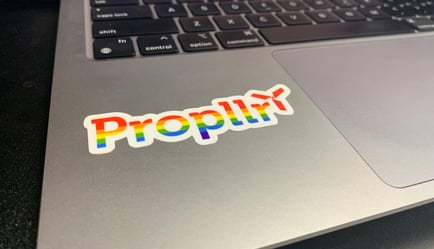Resources to Help You Foster LGBTQ+ Inclusion at Your Startup

It’s that time of year again. The sun is shining. The pools are opening. And companies are changing their logos.
That’s right. It’s Pride Month.
And while it’s encouraging to see Pride enter the mainstream, creating a safe environment for LGBTQ+ employees takes more than adding a rainbow to your company’s LinkedIn banner.
Don’t get me wrong. I do have a rainbow Propllr sticker on my laptop.
 Here’s the sticker, in all its glory!
Here’s the sticker, in all its glory!
But in this blog, I want to share resources that you can use to make your startup a more equitable and inclusive environment for LGBTQ+ people year-round.
Before we get there, I’m going to do a quick breakdown of what LGBTQ+ means.
Let’s get into it!
A Breakdown of LGBTQ+ Identities (and a Little Context)
According to GLAAD’s reference guide, LGBTQ stands for Lesbian, Gay, Bisexual, Transgender, and Questioning. The + indicates other identities, such as intersex, asexual, and agender.
Though non-exhaustive, those are some of the identities of people most affected by LGBTQ+ legislation. And boy, has there been a lot of it in the past decade.
Since the Supreme Court’s decision to uphold same-sex marriage in 2015, more than 1,000 LGBTQ+ bills have been introduced at the state and federal levels (some supportive, some decidedly unsupportive).
And while understanding the acronym is helpful, there’s a lot more you can do to support your LGBTQ+ employees. Which is where these resources come in.
A Guide to Practicing Inclusive Language
We love HubSpot’s guide to practicing inclusive language.
But before diving into it, here’s how HubSpot characterizes inclusive language: “Inclusive language avoids biases, slang, or expressions that discriminate against groups of people based on race, gender, or socioeconomic status.”
The goal? Avoid alienating or excluding groups of people.
While there are plenty of ways to practice inclusive language, here are two simple ones that keep the LGBTQ+ community in mind:
- Push for gender-neutral terms when you can. For example, refer to theoretical people as “they,” not “he” or “she.” Another example: replace terms like “Chairman” with “Chairperson.”
- Ensure you’re using the correct pronouns for people. For instance, if someone uses the ze / zir neopronoun, refer to that person with that pronoun, e.g., “Oh, Taylor? Yes, I spoke with zir yesterday. Ze is still planning to present at the meeting.”
These tips are simple – but that’s the point. Practicing inclusive language is about making tiny tweaks to your language that can make a huge difference for LGBTQ+ people who work with you.
An Article on Forming and Managing an LGBTQ+ Affinity Group
“Connor, what is an affinity group?”
Great question, reader! Indeed defines an affinity group as a “collection of individuals who share a common – and often traditionally underrepresented – identity characteristic.”
Workers generally create these groups – also referred to as employee resource groups or ERGs – to achieve two outcomes:
- Establish safe spaces for discussing company- or industry-wide issues (lack of visibility, inequality, etc.).
- Share networking and professional development opportunities.
Indeed also lays out how to support an affinity group at your company. Important takeaways include:
- Getting, or granting, leadership buy-in. Culture is set from the top, after all.
- Defining the mission and structure of your group. What do you want to achieve and what are the steps you need to take?
- Starting small. Creating an affinity group is about laying a foundation of inclusivity – don’t feel the need to tackle every issue in your first year.
A helpful note: if you’re a smaller startup with only a couple LGBTQ+ team members – or if your employees don’t feel ready to start their own affinity group – search for outside firms with established affinity groups that your team members can join. For example, Propllr is a member of the PR Council, and we tap into its cross-agency ERGs as a way to ensure our underrepresented team members get the additional support they need.
An Article, Blog, and Template on Addressing Non-Inclusive Company Policies
Yes, the last two measures can make your workplace inclusive, but there are other ways you can make life easier for LGBTQ+ employees. Here are three:
- Bathrooms. Chances are, if you’re reading this, you’ve seen the wave of bathroom bills, both in the recent past and in the present day. These bills discriminate against transgender people because they demand people use the bathroom that corresponds to their birth-assigned gender. So what's the alternative? Gender-neutral bathrooms. SHRM lays out how offering gender-neutral bathrooms is one way businesses can demonstrate their commitment to diversity, equity, and inclusion – and attract and retain top talent as a result.
- Parental leave. This blog from Troop HR details how you can rewrite your parental leave policy to fit the evolving definition of family today. For example: what happens if one of your male employees adopts a child with his husband? Which type of leave does he get?
- Your nondiscrimination policy. If your state doesn’t provide full LGBTQ+ non-discrimination protections (check here) consider creating one for your company. Here’s a helpful template to start.
I want to acknowledge that it’s possible some of these things are out of your control in the short term. For instance, maybe you rent an office space that doesn’t offer gender-neutral bathrooms. But thinking about these policies or consulting with your team about them shows that you care about creating an inclusive environment.
If you find that gender-neutral bathrooms are a big deal for your employees, consider requesting that your building add them or looking for an office space that has them before renewing your current lease.
A List of LGBTQ+ Training Opportunities
Most experts will note that education is a crucial component of fostering LGBTQ+ inclusion at your company. Great. But where can you find quality training resources?
These three organizations are a great starting place for Chicago-based startups:
- Brave Space Alliance. We love Brave Space Alliance (check out how many Propllrheads – and Propllr – donated this past year). BSA is a Chicago-based organization that offers a range of LGBTQ-focused training for workplaces, with a specialization in transgender issues.
- LGBTQ+ Workplace Education Center. This organization has a suite of online courses (many of them free) for businesses or individuals (even those outside the Chicago area!). If you need a baseline understanding of LGBTQ+ issues, this is a great place to launch your learning journey.
- Center on Halsted. This Chicago-based community center offers personalized LGBTQ+ competency training for an array of organizations. If for no other reason, use this as an opportunity to check the organization out because Center on Halsted does incredible work.
If you want to learn independently, we advise checking out activists online and following them to cultivate your own network of LGBTQ voices. Nobody is born an expert – we all have things to learn.
Making Your Startup LGBTQ-Friendly Is More Than a Month-Long Commitment
I mentioned it at the beginning of this piece, but it’s worth restating: We’ve made significant progress for LGBTQ+ rights in this country.
But we’re experiencing setbacks.
We’re only halfway through 2022 and the number of anti-LGBTQ bills filed so far this year has already surpassed the total from 2021. Of note: many of these bills attack transgender rights.
This is why it’s so important for allies to speak up and establish systems that protect LGBTQ+ people in the workplace. In this climate, doing nothing can be interpreted as condoning the discriminatory legislation and rhetoric that is sweeping the nation.
But cultivating an inclusive environment supports your employees and communicates to your existing and potential clients that LGBTQ+ acceptance matters to you.
That LGBTQ+ employees and clients deserve to feel safe.
And that you prioritize doing what’s right.







